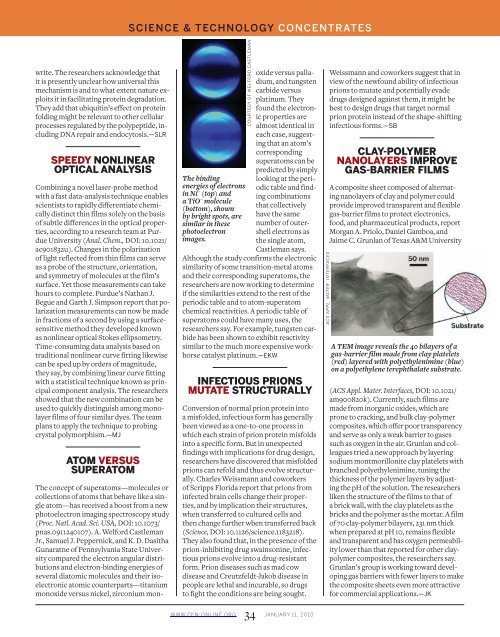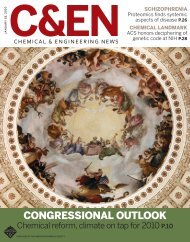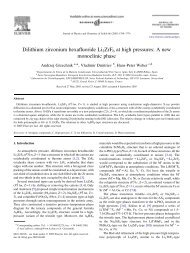Chemical & Engineering News Digital Edition - January 11, 2010
Chemical & Engineering News Digital Edition - January 11, 2010
Chemical & Engineering News Digital Edition - January 11, 2010
You also want an ePaper? Increase the reach of your titles
YUMPU automatically turns print PDFs into web optimized ePapers that Google loves.
write. The researchers acknowledge that<br />
it is presently unclear how universal this<br />
mechanism is and to what extent nature exploits<br />
it in facilitating protein degradation.<br />
They add that ubiquitin’s effect on protein<br />
folding might be relevant to other cellular<br />
processes regulated by the polypeptide, including<br />
DNA repair and endocytosis. —SLR<br />
SPEEDY NONLINEAR<br />
OPTICAL ANALYSIS<br />
Combining a novel laser-probe method<br />
with a fast data-analysis technique enables<br />
scientists to rapidly differentiate chemically<br />
distinct thin films solely on the basis<br />
of subtle differences in the optical properties,<br />
according to a research team at Purdue<br />
University ( Anal. Chem., DOI: 10.1021/<br />
ac901832u). Changes in the polarization<br />
of light reflected from thin films can serve<br />
as a probe of the structure, orientation,<br />
and symmetry of molecules at the film’s<br />
surface. Yet those measurements can take<br />
hours to complete. Purdue’s Nathan J.<br />
Begue and Garth J. Simpson report that polarization<br />
measurements can now be made<br />
in fractions of a second by using a surfacesensitive<br />
method they developed known<br />
as nonlinear optical Stokes ellipsometry.<br />
Time-consuming data analysis based on<br />
traditional nonlinear curve fitting likewise<br />
can be sped up by orders of magnitude,<br />
they say, by combining linear curve fitting<br />
with a statistical technique known as principal<br />
component analysis. The researchers<br />
showed that the new combination can be<br />
used to quickly distinguish among monolayer<br />
films of four similar dyes. The team<br />
plans to apply the technique to probing<br />
crystal polymorphism. —MJ<br />
ATOM VERSUS<br />
SUPERATOM<br />
The concept of superatoms—molecules or<br />
collections of atoms that behave like a single<br />
atom—has received a boost from a new<br />
photoelectron imaging spectroscopy study<br />
( Proc. Natl. Acad. Sci. USA, DOI: 10.1073/<br />
pnas.09<strong>11</strong>240107). A. Welford Castleman<br />
Jr., Samuel J. Peppernick, and K. D. Dasitha<br />
Gunaratne of Pennsylvania State University<br />
compared the electron angular distributions<br />
and electron-binding energies of<br />
several diatomic molecules and their isoelectronic<br />
atomic counterparts—titanium<br />
monoxide versus nickel, zirconium mon-<br />
SCIENCE & TECHNOLOGY CONCENTRATES<br />
The binding<br />
energies of electrons<br />
in Ni – (top) and<br />
a TiO – molecule<br />
(bottom), shown<br />
by bright spots, are<br />
similar in these<br />
photoelectron<br />
images.<br />
oxide versus palladium,<br />
and tungsten<br />
carbide versus<br />
platinum. They<br />
found the electronic<br />
properties are<br />
almost identical in<br />
each case, suggesting<br />
that an atom’s<br />
corresponding<br />
superatoms can be<br />
predicted by simply<br />
looking at the periodic<br />
table and finding<br />
combinations<br />
that collectively<br />
have the same<br />
number of outershell<br />
electrons as<br />
the single atom,<br />
Castleman says.<br />
Although the study confirms the electronic<br />
similarity of some transition-metal atoms<br />
and their corresponding superatoms, the<br />
researchers are now working to determine<br />
if the similarities extend to the rest of the<br />
periodic table and to atom-superatom<br />
chemical reactivities. A periodic table of<br />
superatoms could have many uses, the<br />
researchers say. For example, tungsten carbide<br />
has been shown to exhibit reactivity<br />
similar to the much more expensive workhorse<br />
catalyst platinum. —EKW<br />
INFECTIOUS PRIONS<br />
MUTATE STRUCTURALLY<br />
Conversion of normal prion protein into<br />
a misfolded, infectious form has generally<br />
been viewed as a one-to-one process in<br />
which each strain of prion protein misfolds<br />
into a specific form. But in unexpected<br />
findings with implications for drug design,<br />
researchers have discovered that misfolded<br />
prions can refold and thus evolve structurally.<br />
Charles Weissmann and coworkers<br />
of Scripps Florida report that prions from<br />
infected brain cells change their properties,<br />
and by implication their structures,<br />
when transferred to cultured cells and<br />
then change further when transferred back<br />
( Science, DOI: 10.<strong>11</strong>26/science.<strong>11</strong>83218).<br />
They also found that, in the presence of the<br />
prion-inhibiting drug swainsonine, infectious<br />
prions evolve into a drug-resistant<br />
form. Prion diseases such as mad cow<br />
disease and Creutzfeldt-Jakob disease in<br />
people are lethal and incurable, so drugs<br />
to fight the conditions are being sought.<br />
WWW.CEN-ONLINE.ORG 34 JANUARY <strong>11</strong>, <strong>2010</strong><br />
COURTESY OF WELFORD CASTLEMAN<br />
ACS APPL. MATER. INTERFACES<br />
Weissmann and coworkers suggest that in<br />
view of the newfound ability of infectious<br />
prions to mutate and potentially evade<br />
drugs designed against them, it might be<br />
best to design drugs that target normal<br />
prion protein instead of the shape-shifting<br />
infectious forms. —SB<br />
CLAY-POLYMER<br />
NANOLAYERS IMPROVE<br />
GAS-BARRIER FILMS<br />
A composite sheet composed of alternating<br />
nanolayers of clay and polymer could<br />
provide improved transparent and flexible<br />
gas-barrier films to protect electronics,<br />
food, and pharmaceutical products, report<br />
Morgan A. Priolo, Daniel Gamboa, and<br />
Jaime C. Grunlan of Texas A&M University<br />
A TEM image reveals the 40 bilayers of a<br />
gas-barrier film made from clay platelets<br />
(red) layered with polyethylenimine (blue)<br />
on a polyethylene terephthalate substrate.<br />
( ACS Appl. Mater. Interfaces, DOI: 10.1021/<br />
am900820k). Currently, such films are<br />
made from inorganic oxides, which are<br />
prone to cracking, and bulk clay-polymer<br />
composites, which offer poor transparency<br />
and serve as only a weak barrier to gases<br />
such as oxygen in the air. Grunlan and colleagues<br />
tried a new approach by layering<br />
sodium montmorillonite clay platelets with<br />
branched polyethylenimine, tuning the<br />
thickness of the polymer layers by adjusting<br />
the pH of the solution. The researchers<br />
liken the structure of the films to that of<br />
a brick wall, with the clay platelets as the<br />
bricks and the polymer as the mortar. A film<br />
of 70 clay-polymer bilayers, 231 nm thick<br />
when prepared at pH 10, remains flexible<br />
and transparent and has oxygen permeability<br />
lower than that reported for other claypolymer<br />
composites, the researchers say.<br />
Grunlan’s group is working toward developing<br />
gas barriers with fewer layers to make<br />
the composite sheets even more attractive<br />
for commercial applications. —JK




